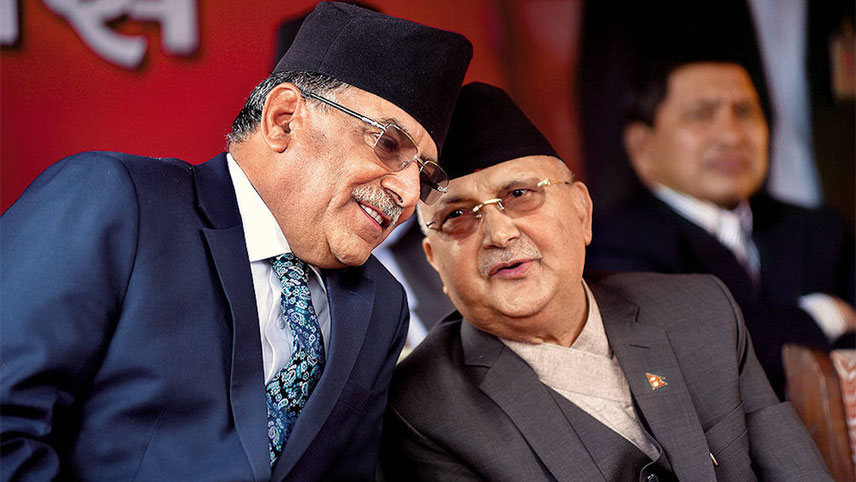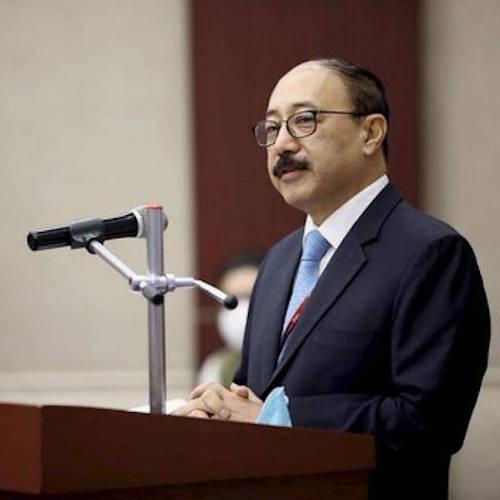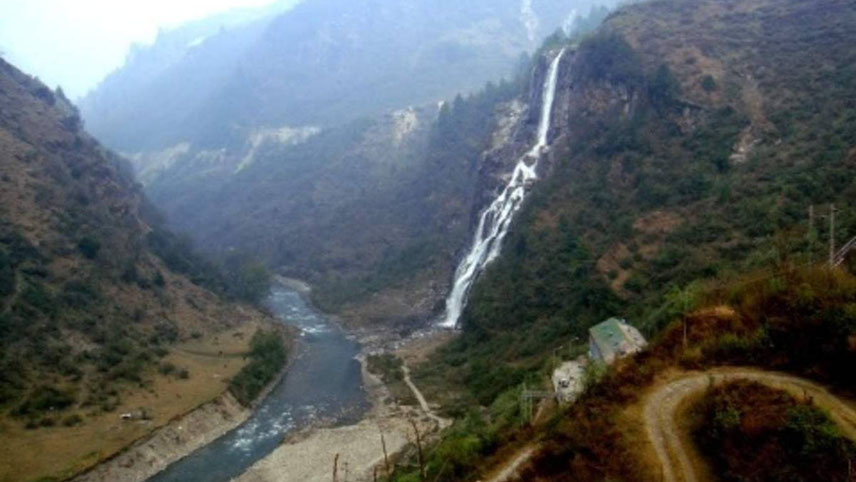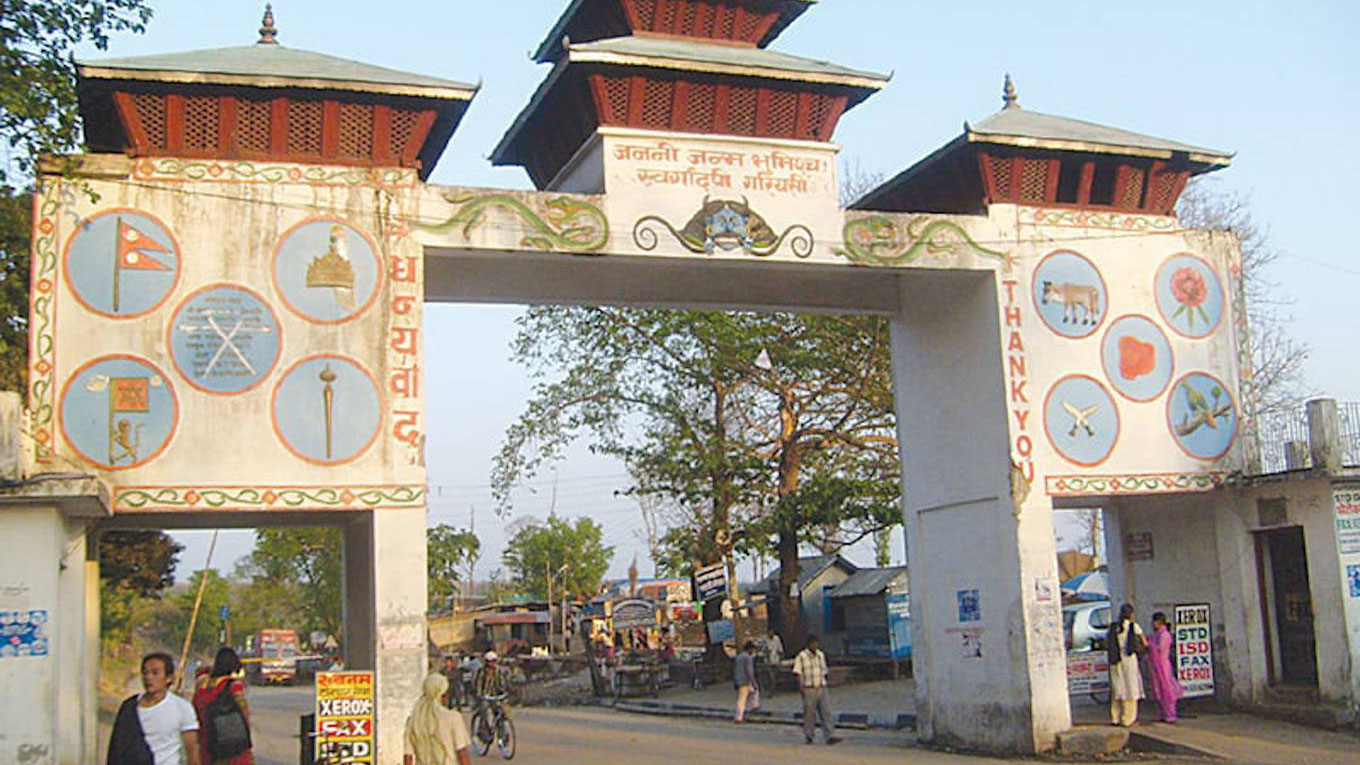-

The internecine struggle between Oli and Prachanda compounded the problems
Nepal is today finding comfort in the Chinese presence not because New Delhi and Prime Minister Narendra Modi have not been reaching out. Since Modi’s first term in 2014, there have been 16 meetings at the head of state/government level, with Modi visiting Kathmandu four times and Oli visiting India seven times. One needs to remember that Nepal has one of the world’s youngest populations and, after India’s support of the 2015 blockade, anti-Indian sentiments have been running high. This offers a new generation of Nepali politicians a powerful tool to mobilise the electorate.
Diplomatically, Nepal has made it clear that it wants to go ahead with both India and China. “China is stepping up its engagement with South Asia, in general, and Nepal, in particular, including on defence and security issues,” says Ranjit Rae, former Indian ambassador to Nepal. “Nepal believes that it has successfully balanced its relations with both India and China.”
For a land-locked country, this is clever politics. “Nepal’s foreign policy establishment has embraced an ambitious and forward-looking agenda of external balancing and diversification in recent years under the leadership of its foreign minister Pradip Gyawali,” says Constantino Xavier, fellow, Brookings India. By participating in the Fourth Indian Ocean Conference in the Maldives last year, Nepal is seeking to place itself as a critical connectivity hub between China, South Asia and the Indian Ocean region. It follows then that, henceforth, India will have to go out of its way in handling Nepal, if it is to compete with China.
Old times
It wasn’t like this always. When India was Nepal’s dominant trade partner, thousands of people from both sides crossed the 1,753-km open border every day to work, buy, sell and transact businesses, accounting for about 60-65 per cent of all trade. A network of informal arrangements across borders made this possible. Cousins dealt with one another across the borders; as did business associates, with sons and daughters married into each other families. Lenders and suppliers that offered credit based on family references. Cash, which moved easily across the border, was king.
However, with demonetisation, roll-out of Goods and Services Tax and growing formalisation of the Indian economy, contracts had to be inked and complex documentation was needed to move goods across borders. Stronger controls are now making it difficult to move cash and make payments. For many small and medium businessmen in Nepal, it is now easier to trade with China. This isn’t because China has rendered India uncompetitive. Rather, the rules have made it harder to do business with India.
The trend has translated into a larger role for Chinese business. Once the single largest source for FDI, India has seen its position erode with growing Chinese investments. In 2019, for instance, China accounted for about 40 per cent of new FDIs, against India’s 30 per cent. Also, about 1,500 Chinese firms had received approvals for FDIs in Nepal. This was twice the number of Indian firms that had been approved for foreign investment. China overtook India as the biggest FDI source for Nepal in 2014. Now, reportedly, in the first quarter of this year, 90 per cent of Nepal’s FDI has come from Beijing.
-
Once the single largest source for FDI, India has seen its position erode with growing Chinese investments. In 2019, for instance, China accounted for about 40 per cent of new FDIs, against India’s 30 per cent
China announced its arrival as the pre-eminent investment partner of Nepal first in 2017 at an Investment Summit in Kathmandu. Chinese firms made investment pledges of $8.4 billion out of the total investment pledges of $13.5 billion; while Indian firms committed only $317 million. The investment commitment by Indian firms in that event was even lower than that of Bangladesh, Sri Lanka, Japan and the US. In the past, Indian investors were no less important. More than 150 Indian ventures have been operating in Nepal, which accounts for the 30 per cent of the country’s total FDI.
Indian firms have been working in all such areas as manufacturing, banking, insurance, education, telecom, power, tourism and various other sectors. They include Surya Nepal, Dabur India, Hindustan Unilever, Asian Paints, GMR India, Manipal Group and MIT Group Holdings, apart from a clutch of PSUs. “Indian investors want to invest more in Nepal,” acknowledges Saibal Ghosh, vice-president, Nepal-India Chamber of Commerce & Industry and co-ordinator, when asked to explain the tepid Indian interest. “But there are some provisions regarding sending dividends and service-related payments from Nepal to India, which should be eased to boost it further.”
Border closure
Another factor is the current closure of the open border between Nepal and India. The open border is a unique arrangement, which facilitates the unrestricted cross-border movement of people from one country to the other. The citizens of these countries are not required to hold a visa or passport to travel within the two nations. But, after the outbreak of Covid-19, Nepal has closed its international boundaries with both India and China, to prevent transmission of the virus. India also closed the border with Nepal but re-opened it sometime back, though the latter has not yet followed suit. This has caused immense miseries in the lives of hundreds of thousands of people, who used to cross the border each day for social, cultural, religious, economic or even political grounds. Businessmen in particular are demanding re-opening of the border to resume trade. “People on both sides of the border have roti-beti relationship,” says Ashok Kumar Baidya, former president, Birgunj chamber of commerce & industries. “And they are now facing immense hardships.”
India had been holding off on a diplomatic outreach for most of this year to convey New Delhi’s displeasure over the Oli government’s move to issue a new political map of the country, which included a slice of land covering the Limpiyadhura, Lipulekh and Kalapani areas that fall in Pithoragarh district of Uttarakhand. The 370 sq km strip has been under Indian administration for a long time. But Nepal argues that, under the terms of the 1815 Treaty of Sugauli, signed between the Gurkha rulers of Kathmandu and the East India Co, after the Gurkha War/Anglo-Nepal War (1814-16), the land belongs to it and should be returned. New Delhi had rejected the map, brushing aside what it had said was Nepal’s ‘effort at a cartographic expansion’.
-

Shringla: not a single agenda visit
Bone of contention
The real reason is that Lipulekh is the tri-junction where China-India-Nepal borders meet, say Indian officials. As a military strategy, India cannot lose control over this land, particularly after China’s intrusions in Ladakh. On 8 May, defence minister Rajnath Singh inaugurated the 80 km Darchula-Lipulekh pass link road, cutting across the area under contention. The road was meant for the use of the army as well as Indian pilgrims going to Kailash Mansarovar. Nepal hit back by summoning Vinay Mohan Kwatra, Indian Ambassador to Nepal, to convey a formal protest.
Of late, however, Nepal has been working at mollifying New Delhi and has even withdrawn school textbooks that contained the new political map. But that could be a ruse. Nepal had published a revised official map incorporating the territory from the Limpiyadhura source of the Kali river to Kalapani and Lipulekh pass in the north-east of the triangular region as its territory. On 22 May, the Cabinet led by Oli adopted a constitution amendment motion to grant constitutional status to the map. Observers say this move renders any future solution on the land dispute nearly impossible, as a constitutional guarantee will make Kathmandu’s position inflexible.
Power struggle
The problems in Nepal have been compounded by the internecine struggle between Oli and Prachanda. Serious allegations of corruption, nepotism and authoritarianism have been levelled against Oli by a majority of the nine-member Central Secretariat of the NCP. To deflect the heat, Oli has taken to India-bashing, claiming that India was trying to destabilise his government and ‘the Indian embassy is active in it’.
According to observers in New Delhi, the struggle may have something to do with the fact that the formation of NCP was the result of a merger, brokered by China, between Nepal’s Left parties – the Communist Party of Nepal-Unified Marxist Leninist (UML), headed by Oli, and the Communist Party of Nepal-Maoists, led by Prachanda. Both the leaders were to function as co-chairmen of the party and take turns in occupying the PM’s post.
However, early this year, Prachanda made a statement that he had agreed to let Oli continue for the five-year term, apparently after Oli assured him that he (Prachanda) could function as party chief with untrammelled executive authority. However, Oli hasn’t kept his part of the bargain and has been taking all major decisions and exercising the party chief’s duties, reportedly without even informing Prachanda at times.
Nepal’s President Bidya Devi Bhandari has tried to intervene in the crisis but without much success. More interesting has been the intervention of the Chinese ambassador to Nepal, Hou Yangqi – a role which the Indian ambassador had played once, to sort out the creases within the Nepali Congress. So far, Oli has been buying time to respond to the allegations.
-
To wrest back its position of Nepal’s primary partner, India will have to put in sustained diplomatic effort. Success in this regard will not come quickly given the enormous influence China wields over Nepal
New Delhi’s response
Alarmed by the growing footprint of China in the nation’s politics and economy, India last month sent Research & Analysis Wing chief Samant Kumar Goel to do some fire-fighting. Subsequently, the Army Chief General M.M. Naravane visited Nepal, where he was conferred the rank of honorary general of Nepalese army. (This is an old tradition, as thousands of Nepal’s Gurkha soldiers are serving in the Indian Army. The chief of Nepalese army is also an honorary general of the Indian army.) Both the visits sparked off a controversy. There was even resistance within the Oil cabinet over General Naravane’s visit.
Now, Foreign Secretary Harsh Vardhan Shringla has travelled to Kathmandu, beginning what could be a formal dialogue between the two countries – a sign that New Delhi is willing to go an extra mile to improve bilateral ties that had nosedived earlier this year. Shringla, who belongs to Sikkim, is fluent in spoken Nepali, a language he used to disarm his interlocutors. His conversations in Kathmandu are also expected to break the ice and lead both sides to finalise the schedule for the meeting of the Joint Technical Level Boundary Committee.
In a follow-up to Shringla’s visit, the commerce secretaries of India and Nepal held a virtual meeting on trade and transit issues. An interesting idea that came up was the creation of cross-border economic zones, an extension of cross-border trade infrastructure. This is an idea that has developed into many forms over the last decades, particularly among Asean countries and between Asean countries and China. The objectives of this co-operation are to utilise the advantages of connectivity in the border areas for economic development. Vietnam is a key player in this process. The country has the land border exceeding 4,500 km in length with China, Laos and Cambodia. The economic think tank ICRIER had recently mooted cross-border economic zones between India and Nepal.
But this is easier said than done. “Cordial relations between India and Nepal do pave the way for successful entrepreneurial ventures,” acknowledges Binod Chaudhary, Nepal’s leading businessman & maker of the immensely popular Wai Wai noodles. “But when differences appear, bilateral economic ties get adversely affected.”
‘Festering sore’
To foster healthier economic ties, both sides will have to first sort out the boundary issue, which is contentious and long-pending. It will require more than a committee to resolve the dispute. The border dispute (concerning the eastern-most corner of Uttarakhand’s Pithporagarh district) between Nepal and India got revived in November 2019, at a time when the Modi government was basking in the glory of scrapping Article 370 of the Constitution. India published a revised political map showing the newly created Union Territories of Jammu & Kashmir and Ladakh.
The map showed Kalapani, to which both India and Nepal lay claim, as part of Pithoragarh. Nepal protested immediately and drew attention to the lingering issue. Kalapani shares a border on the north with the Tibet Autonomous Region of China and Nepal in the east and south. In fact, the region resembles a slice of cake wedged in between Limpiyadhura, Lipulekh and Kalapani. The area is in India’s control but Nepal claims the region because of historical and cartographic reasons.
-

Pancheshwar multi-purpose project: will it revive a robust relationship between the two countries?
The Kalapani region derives its name from the river Kali. Nepal’s claim to the region is based on this river, as it became the marker of the boundary of the kingdom of Nepal, following the Treaty of Sugauli. According to the treaty, Nepal lost the regions of Kumaon-Garhwal in the west and Sikkim in the east. According to Article 5, the King of Nepal gave up his claims over the region west of the river Kali, which originates in the High Himalayas and flows into the great plains of the Indian sub-continent. According to the treaty, the British rulers recognised Nepal’s right to the region that fell to the east of the river Kali.
Herein lies the historic origin of the dispute. According to Nepali experts, the east of the Kali river should begin at the source of the river. The source according to them is in the mountains near Limpiyadhura, which is higher in altitude than the rest of the river’s flow. Nepal claims that a land mass, high in the mountains that falls to the east of the entire stretch starting from Limpiyadhura downwards, is theirs. India, on the other hand, says the border begins at Kalapani, which India says is where the river begins. The dispute thus is mainly because of the varying interpretation of the origin of the river and its various tributaries that slice through the mountains.
Strategic angle
There is a strategic angle as well. The importance of Himalayan passes with the Tibetan plateau was amply highlighted in the 1962 war. During that war, Chinese forces used the pass of Se La in Tawang and reached the Brahmaputra plains in the east. The military defeat in the east clearly demonstrated that weakly guarded passes were a major vulnerability of Indian military preparedness against China. In comparison to Se La, which was somewhat fortified, Lipulekh was vulnerable.
Officials stress that the boundary issue was only one aspect of Shringla’s visit, which was aimed at repairing the fabric of India-Nepal ties. “This was clearly not a single-agenda visit,” a senior diplomat said. Depending on how things pan out, India may commit to help Nepal with corona-virus vaccines once its production starts. Also, the two sides will discuss the revival of the Pancheshwar multi-purpose project on river Mahakali as well as other hydro-electric projects. But whether a robust relationship can materalise after so much of water has flown down the Kali river remains to be seen.
As close neighbours, both Nepal and India share many things in common, with the dominant Hindu religion being a binding factor once. Yet, this isn’t helping now, which is ironical, considering that India is run by a party weaned on a Hindu nationalist ideology. Perhaps this may have something to do with the fact that Nepalis have a history of religious tolerance. In 2006, Nepal became a secular country after it ousted the old constitutional monarchy, when the Indian government, run by the Congress-led UPA, helped push former Maoist rebels to a peace deal and into mainstream politics.
-
As close neighbours, both Nepal and India share many things in common, with the dominant Hindu religion being a binding factor once. Yet, this isn’t helping now, which is ironical, considering that India is run by a party weaned on a Hindu nationalist ideology
Pending projects
To catch up with China, India has a lot of work to do. For instance, besides the boundary disputes, most of the India-funded development projects, including the Postal Highway Project, have remained incomplete for years. The road runs across the Terai region of Nepal from Bhadrapur in the east to Dodhara in the west, cutting across the entire width of the country. India is developing 300 km of the total road, while the rest of it is being developed by Nepal. Had this road been completed on time, the people from both the sides would have reaped economic benefits as a result of better connectivity. The proposed Pancheshwar Multipurpose Hydel Project has yet to kick-start, though an agreement to this effect was reached 24 years ago, when both the sides signed the Mahakali Treaty to share the water of the Mahakali River.
This ambitious project includes setting up of two hydro-electric plants with a total installed capacity of 5,040 MW and a 315 metre-high dam to meet the power and irrigation requirements of the two countries. The dam, once complete, can irrigate 170,000 hectares of land in Nepal and 259,000 hectares in India, besides meeting the electricity requirements of the two countries. The funding of the project, estimated to cost Rs40,000 crore in 2017, was to be jointly shared between India and Nepal. Even if the cost has gone up to Rs50,000 crore now, surely India can fork out this amount and create goodwill in Nepal!
People lose faith in their government and neighbour, when formal bilateral deals are not executed within the deadline set by both the sides. It is high time Nepal and India took up these issues seriously, activating the existing joint mechanisms to get the desired results of the agreed joint projects.
To wrest back its position of Nepal’s primary partner, India will have to put in sustained diplomatic effort. Success in this regard will not come quickly given the enormous influence China wields over Nepal. For instance, close on the heels of Shringla’s visit, Chinese defence minister Gen Wei Fenghe visited Nepal to bolster military co-operation. Beijing’s unprecedented political interference in Nepal is accompanied by strengthening economic, political and defence co-operation. Can India match that? The forthcoming visit of Nepal’s foreign minister Gyawali for the VIth Joint Commission meeting in New Delhi will provide some clues.





































